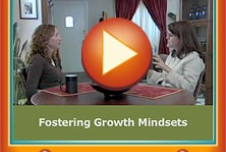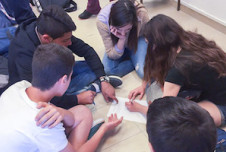Some people are just jerks, and not much can be done to change them.
Do you agree with this statement? If your answer is yes, here’s something you might consider: Research suggests that believing in the human capacity to change is linked to less depression, better health, and greater achievement.

This is the “growth mindset,” an idea pioneered by Stanford researcher Carol Dweck. It’s the opposite of a “fixed mindset,” the idea that people are born either smart or not, kind or not, strong or not—and people just don’t change all that much.
According to this research, when we practice a growth mindset, the obstacles we’re facing seem more surmountable. It’s crucial for us to realize that we are not helpless; we can grow and adapt. Just as important as seeing ourselves as capable of growth, however, is the belief that someone who is challenging us can change, too. This perspective releases some of the pressure we might feel, and helps us to think more in terms of challenges than threats.
We shouldn’t only believe in the ability of other people to change for their benefit, however. We are the ones who stand the most to gain when we see possibilities in others. For example, one recent study found that teens who learned about the growth mindset in relation to bullying—hearing that bullies could change, and no one was stuck as an aggressor or victim—were more resilient to social stress. Even when they got ignored or felt shy, for example, they didn’t become overwhelmed or physically stressed out. Seven months later, they were even getting better grades.
That’s a fairly easy idea to suggest, and perhaps you already believe in it. But if you’re a parent or educator, the challenge lies in helping kids to see the advantages and the ways that it can be applied to their lives and relationships. Here are some tips for helping kids turn a fixed mindset into a growth one.
How to explain the social benefits
Although there is some controversy over the misapplication of mindset research in schools, a growing number of studies suggest that fostering a growth mindset (also known as an “incremental theory of personality”) helps students to better navigate social challenges.
- Improved peer relationships: A simple belief in the possibility of change may have a powerful effect on our thinking—potentially freeing us to actually see our way through anxiety and a sense of failure in the midst of peer conflict and peer exclusion. Research also indicates that believing personalities can change can lower aggression and retaliatory behavior.
- Empathy: A growth mindset can prompt us to put in the effort to empathize more—particularly when it’s challenging. If we are struggling to understand that so-called “jerk” in our lives, we might be able to say to ourselves, “This person may be having a rough time right now, but she may change her behavior over time.”
- Cooperation: Finally, if we believe that personalities are malleable and situations can change, we can also apply this thinking to groups. Israeli and Palestinian teens who were taught the simple idea that groups of people can also change demonstrated increased cooperation in a joint tower-building task. They showed more positive emotions and built a much higher tower than the control group participants in the study.
“Believing in the human capacity to change is linked to less depression, better health, and greater achievement.”
Although the basic message above seems to yield numerous social benefits, researchers caution us not to default to oversimplified “people-can-change” platitudes as we share information about the growth mindset. It’s not okay to put all the burden on someone who is being bullied or otherwise facing unfair circumstances. When we address bullying and victimization, both bullies and bystanders must be part of the conversation—and the solution.
Three ways to teach a growth mindset
Many growth mindset studies feature brief reading and writing activities where participants learn about our human potential for growth, apply their learning, and share it with others. If you would like to recreate a similar learning experience at home or in your classroom, here are some elements you might include.
- Talk about bullying and social exclusion: Why do bullies bully? Are victims always victims? What traits do bullies and victims share? Can bullies or victims change? The goal here is to challenge black-and-white views of “bullies” and “victims.” Exploring these questions can help us realize that neither bullies nor victims are fundamentally flawed or fated to always remain in their role.
- Explore growth vs. fixed mindsets: With the help of these two videos, you can introduce the concept of neuroplasticity and what it means to hold a growth vs. a fixed mindset. Viewers should start to understand how believing that people’s abilities and traits can change makes us more motivated and optimistic about solving problems. Then, you can apply these concepts to the idea of bullying: Can bullies and victims grow and change? How can we shift some of our fixed ideas about them—He’s a bad person; No one likes me—to more flexible ones?
- Reinforce learning through teaching: Research demonstrates that learning and comprehension can be significantly enhanced when you get to teach what you are learning. Invite older children or teens to develop several tips and discussion questions about the growth mindset. Then find a time when they can share these key ideas with younger children (or siblings).
Obstacles to growth
Consider the following cautions and clarifications from mindset researcher Carol Dweck:
- You can’t have a growth mindset all the time: It’s important to note that a growth mindset isn’t a personal attribute or state of being, it’s a way of thinking or a coping strategy that we can apply in a given situation. It is not something you simply have or you don’t.
- We all experience fixed mindsets, too: Everyone is a mix of both fixed and growth mindsets, and no one person has a pure growth mindset all the time. If we want to benefit from a growth mindset, we need to understand how both a fixed and growth mindset can play out in different situations. For example, a growth mindset can come in handy in situations where we experience anxiety or a sense of failure.
- Beware of your triggers: However, sometimes it’s really challenging to access a growth mindset. Fixed-mindset triggers such as feeling threatened, compared, or criticized can make us feel defensive and insecure so that it can be difficult to believe in the capacity for change. Fixed mindsets can also spark negative self-conscious emotions like shame, which can spark signs of stress in the body as we react to potential threats.
Studies suggest that growth mindsets counter the fight-or-flight response, helping us to view social problems as challenges. This helps us to adapt, change, and grow—the chief characteristics of resilience. When we promote the belief that people truly have the potential to change, we free up ourselves and others to actually do that.








Comments